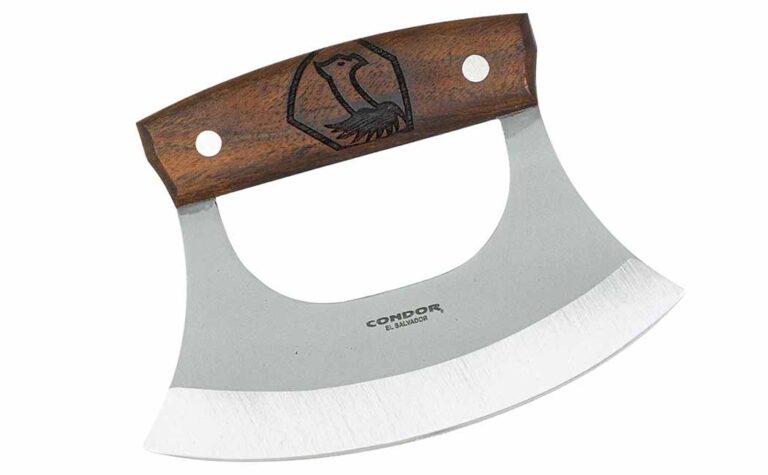
The Ulu knife has grown in popularity in recent times. We cover the origin of this traditional knife of the north, how it’s used and some of the best modern options.
The Ulu knife has become increasingly popular in recent years among chefs, ardent home cooks, homesteaders and more. Traditionally a food preparation knife, this unique blade has come to be used for various household, hunting, cooking, and survival tasks.
Today we’re going to take a close look at this incredibly versatile tool, including its fascinating history among the native peoples of Alaska, how it is used, and how it stacks up against other similar knives. Then we’ll take a deep dive into the top 8 best Ulu knives currently on the market.
Let’s get started.
History of the Ulu Knife
The Ulu knife has its origins as a traditional tool used by the Inuit, Iñupiat, Yupik, and Aleut people of Alaska, Canada, Greenland and far Western Russia. Throughout history, these knives were used primarily as tools around the home, including for sewing, food preparation, and butchery—depending on the size of the knife.
Originally made with a walrus ivory, muskox horn, or caribou antler handle with a slate blade, modern Ulu is typically made with a wooden handle and steel blade, often reforged from a bartered saw or spade blade in traditional communities.
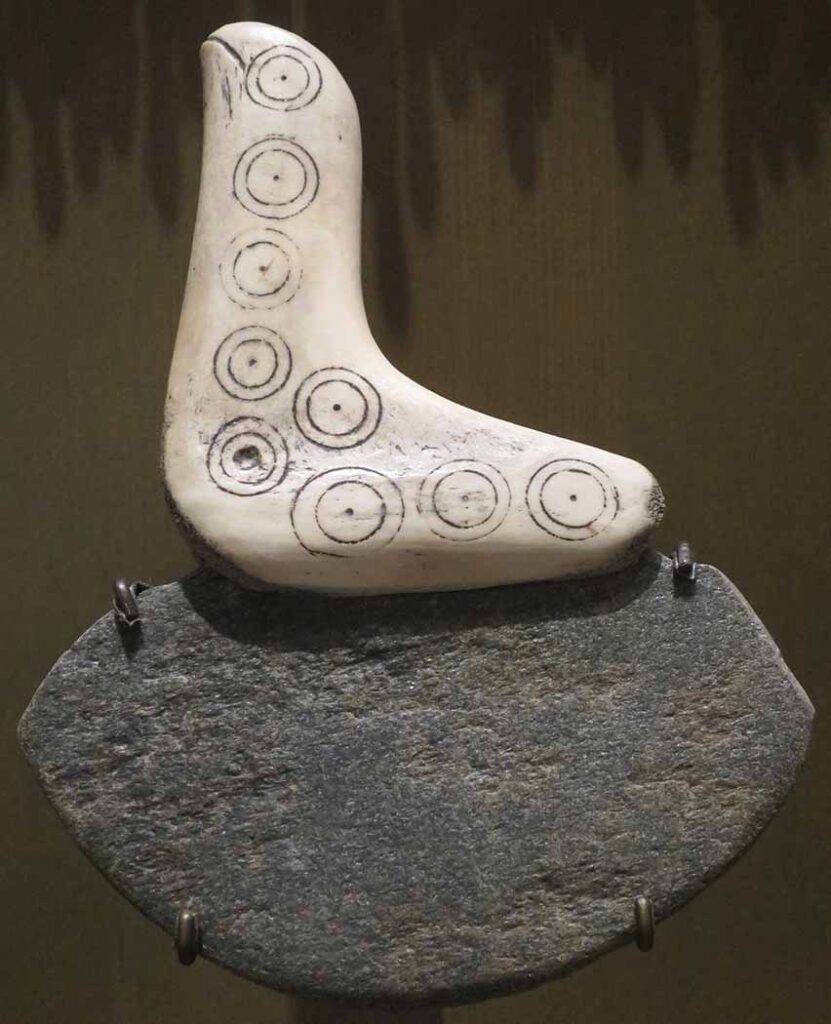
While materials have changed, the design has remained much the same, with a wide, curved-edge blade mounted in front of where your knuckles when gripping the handle. It’s almost like a push dagger but with a wide, single-edged blade on the same axis as the handle.
There are a few regional variations where the blade is attached by a central stem to the handle, but in most versions, the handle is attached at each end of a curved blade.
Today, the knife is growing in popularity all over the world for food preparation, while still being used every day in the indigenous communities where it was first brought into the world. The Alaskan style is most prevalent, with a wide, crescent-shaped blade attached at one or both ends to the handle, but there are definitely other versions out there as well.
Using the Ulu Knife
The Ulu knife has a curved blade designed primarily for either a scraping or in a rocking motion, but it can also effectively chop and slice much like a Western-style chef’s knife.
It is very similar to a sharpened bench scraper in some ways, and can easily be used to gather up chopped ingredients. It can also be used to break down a carcass and is very efficient at chopping through bones, much like a heavy cleaver.
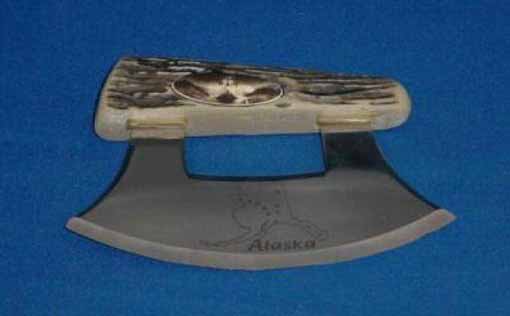
Smaller versions are also traditionally used for household tasks like sewing, working with hides or leather and even wood carving. Larger versions with blades up to 12 inches are also sometimes used as everything from a cleaver to a draw knife.
For most people though, the Ulu is a kitchen tool, something to make prepping meats, fruits, vegetables, and herbs easier when getting lunch or dinner ready. It has a variety of uses beyond that, but for most, it has earned its reputation as a stellar kitchen tool.
Pros and Cons of the Ulu Knife
The Ulu knife is an extremely useful knife, and very versatile, but it can’t quite do everything. Here are some pros and cons of this awesome traditional tool.
Ulu Pros
Kitchen Prep: First and foremost, it’s great for most kitchen prep tasks. Fileting a fish or carefully deboning a chicken might be a struggle, but for everything else, it is a very fast and effective way of taking big chunks of ingredients and making them smaller.
I personally love using one to chop herbs and leafy vegetables where the wide blade and curved profile make long rocking and slicing motions feel very nice. If you frequently find yourself chopping up fresh herbs from the garden, this is a great tool to have on hand.
Game/Meat Processing: It also does a great job of breaking down animal carcasses, as well as dealing with large chunks of meat like a rack of ribs or a whole chicken. That wide cleaver-like blade may not be ideal for chopping through something like beef neck, but for smaller bones you can easily press the blade against, you’ll have no trouble at all.
It’s also very good for scraping meat off of a bone, quickly chopping up root vegetables, halving large fruits or vegetables like navel oranges when you’re making juice and things of this nature. It also makes a phenomenal pizza cutter (which is one of the primary uses mine sees).
Bushcraft: Outside of the kitchen, it is of course still a sharp piece of metal with a handle, so its use is limited only by your own creativity. They work great for a variety of camp tasks, so if you’re looking for one knife that can really do it all in the backcountry, you could certainly do worse.
Splitting small pieces of wood, making feathersticks, carving a quick replacement tent stake, cutting cordage, and other similar tasks are all well within the Ulu’s abilities.
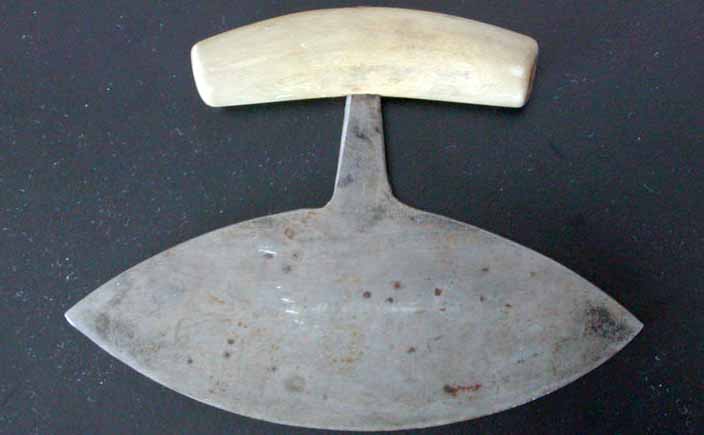
Ulu Cons
Cutting-Style Adjustment: The biggest problem with the Ulu knife is that using it requires a bit of a different motion than your typical Western-style chef knife, or even something like a Santoku because of the handle’s placement.
The chopping or slicing motions you’re used to are going to take some adjusting if you want to use an Ulu effectively. It’s not a huge change for most people, but if you have a lot of muscle memory and knife skill with more common kitchen knives, it is definitely an adjustment.
Somewhat Limited Scope: The other big issue is that the size and shape of the knife make it unsuited for some tasks, but you can say the same thing about any knife really. Still, you’re going to have a rough time filleting a small fish with this knife.
Other than that, the handle design of the Ulu makes things like slicing through very thick material or produce difficult if not impossible, so reach for something else when carving through something like a large watermelon or what have you.
Buyers Guide: 7 Best Ulu Knives on the Market Today
Now, let’s take a look at the best Ulu knives on the market today. These are the knives that offer something beyond the competition in terms of value, features, design, or workmanship.
Condor Ulu Fixed Blade Knife Walnut Wood
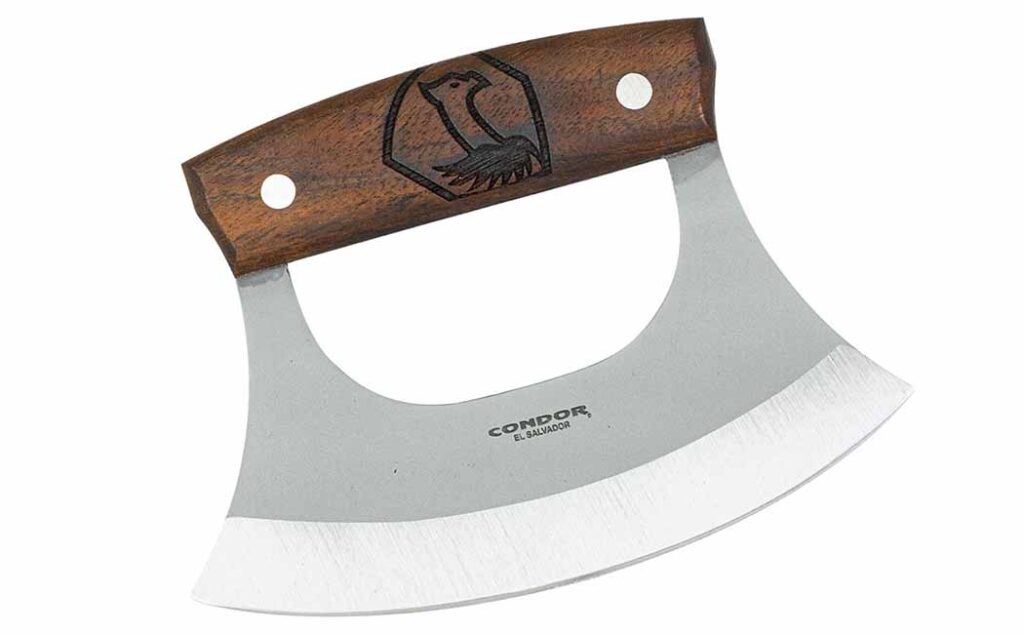
Condor Tool & Knife has made a name for itself across the knife world by providing high-quality knives to meet a variety of needs (and budgets). Their take on the Ulu is made in a very traditionally-Alaskan way, with a curved blade attached to a handle at both ends.
The beautiful walnut handle is engraved with Condor’s logo and features stainless pins attaching it to the blade. The handle is very comfortable and shaped well for most hand sizes. This may not be the knife to hand your kid when teaching them to chop veggies for the first time, but beyond that, it should work well for just about everyone.
The blade itself is 6-inches long and is made of high-carbon 1075 steel, and is hollow ground with a thin edge to facilitate chopping, slicing, dicing, and other kitchen tasks. The knife also comes with a welted leather pouch that is made by hand.
Gerber Downwind Ulu
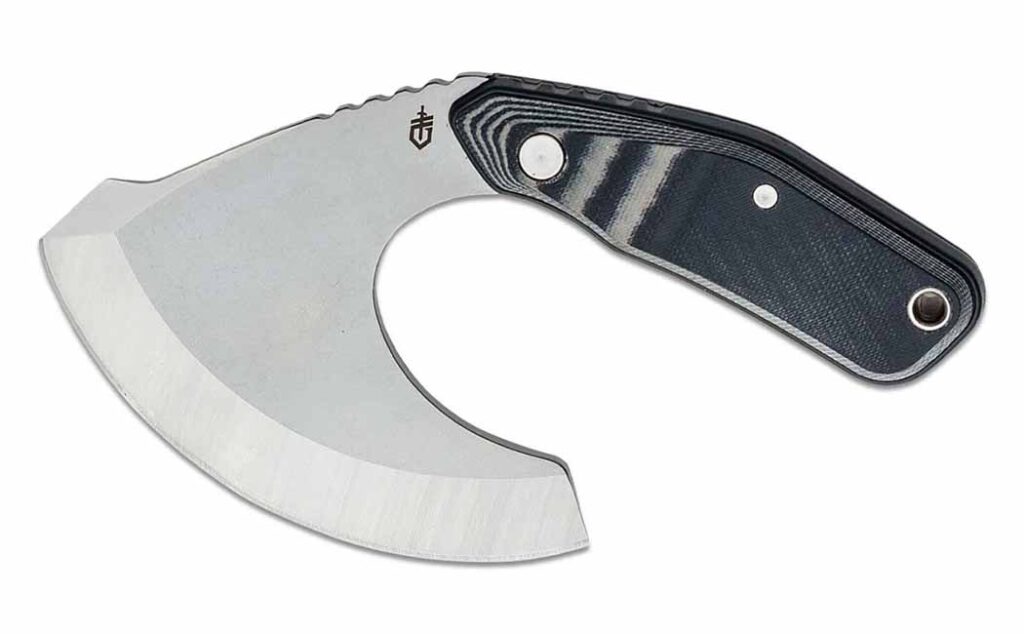
Gerber’s budget-friendly knives often offer great value for the money, and their Downwind Ulu is a great example of this.
Made of high-chromium stainless steel like many mid-range survival knives, the Downwind Ulu is a great camp knife for folks who like cooking more involved meals in the backwoods, and it can still be used for other camp tasks.
It uses a more modern design, with a handle that is more like a cleaver or a small hatchet really, but the overall ergonomics are still very much in line with the traditional Ulu. If you’re looking for a hybrid between your typical chef’s knife and an Ulu, this is a great option.
The handle is a very grippy G10 that is comfortable in the hand, even if you have wet hands, and there is considerable jimping on the spine of the blade to give you extra grip when doing detailed work like skinning game or gutting a fish.
The blade is 3.5 inches long and made of 7Cr17MoV steel.
Lamson Ulu Knife
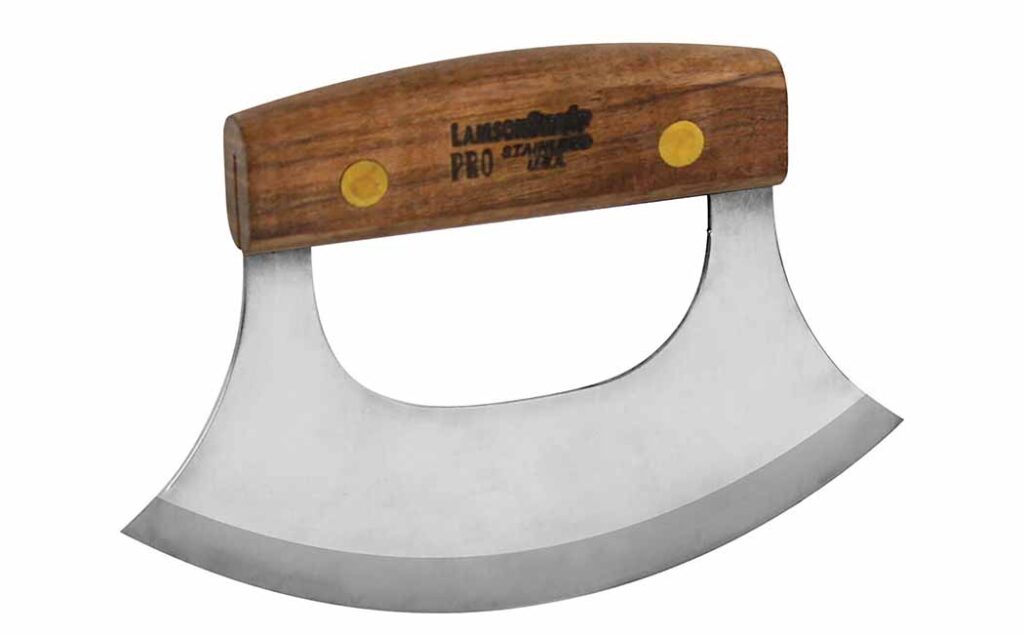
The Lamson Ulu knife is another take on the classic Alaskan Ulu and is made in America. It features a natural walnut handle that is affixed with brass rivets and uses a half-tang construction.
This particular Ulu is made in Massachusetts and is hand finished and sharpened to give it that extra bit of polish. The blade is a high-carbon stainless tempered to a 58 Rockwell hardness so it holds an edge well without being brittle or prone to rolling when cutting something tough.
It also comes with Lamson’s lifetime warranty, which covers any manufacturing defects in perpetuity, and also includes a lifetime of professional sharpening so when you do need to give the edge a touchup, you can send it to them if you don’t feel like doing it yourself.
If you’re looking for a budget-friendly Ulu to use for processing vegetables, slicing pizza, and dealing with other food-prep tasks, this is a great option that will look sharp (pun intended) in any kitchen.
The blade is 3 inches wide (on this version, there are several) and made of 420-HC LAM S/S steel.
Ezina Designs Walnut Inupiak
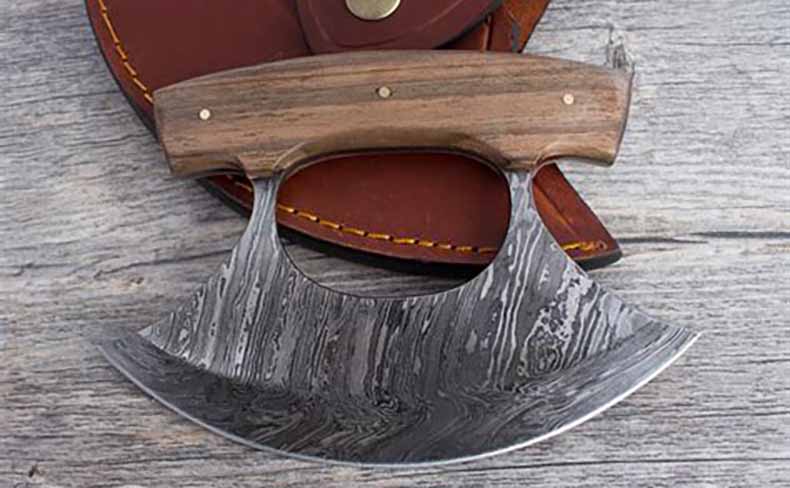
This knife by Ezina Designs is made by North Star Knife & Ulu Company and is handcrafted to be rugged and durable in real-world use. This knife is made in Alaska, and the beautiful damascus blade is made of 1074 and 15N20 carbon steel and features a high nickel content.
This high nickel percentage contracts the grain of the metal and helps it resist corrosion so it can stand up to some heavy use and abuse in the field. The gorgeous walnut scales hide a full-tang construction, and the whole handle is set together with three brass through-pins.
It also comes with a handmade leather pouch sheath that Ezina Designs will custom engrave for you with three characters of your choosing, making this a phenomenal gift for the chef or foodie in your life, especially if they also love the outdoors.
Ezina Designs Antler Mini Ulu
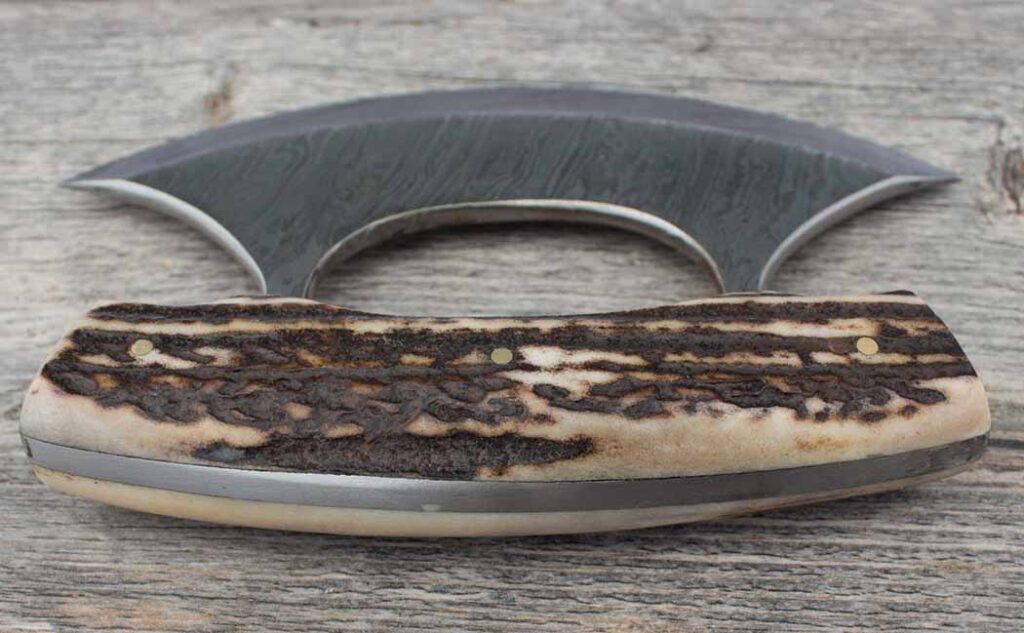
Another North Star Knife & Ulu product, this smaller Ulu has a 4” blade that makes it a bit more portable, or perfect for storing out of sight and out of mind with a small cutting board in something like a camper or boat.
It features a gorgeous antler handle, and the same awesome damascus steel featured in the above offering. Because it has such a small blade (relatively speaking at least) it utilizes the more Western style of Ulu more common in Greenland with a thick singular stem connecting the blade to the handle, as opposed to the handle being connected to both ends of the blade.
Overall, if you like the traditional aesthetic and want a small vegetable chopper or camp knife, this is a great option.
Hibben Legacy Ulu Knife
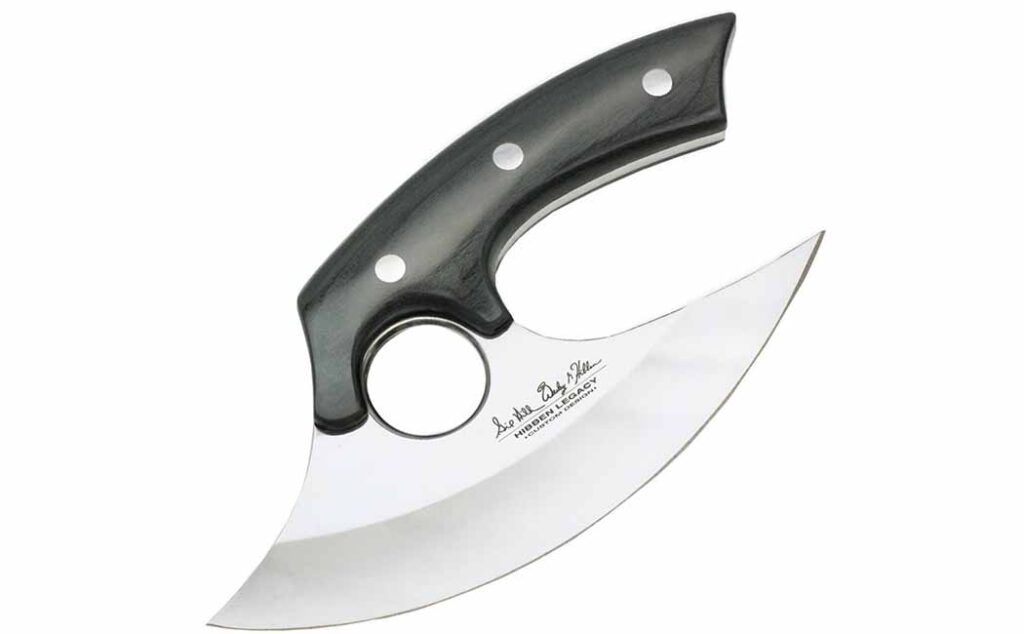
Gil and Wes Hibben are both legends in the knife world, so it’s probably no surprise that they’ve turned their attention to the Ulu. Their take on this traditional knife has a modern design, which you probably expect if you’re familiar with their work.
The stainless steel blade is attached to one end of the handle in the updated hatchet-like fashion we see with some modern Ulus and is 6.5” in length so it’s perfect for kitchen and camp tasks. The stainless doesn’t hold an edge as well as some of the carbon steel options on this list, but of course, will be more resistant to corrosion and rust.
The blade on this thing is beefy so if you’re looking for something to really hack into thick pieces of meat or chop through bones, this is a great option. It’s also durable enough for some tasks around camp, making this a great one for the backcountry cooks out there.
Bushmaster Survival Ulu
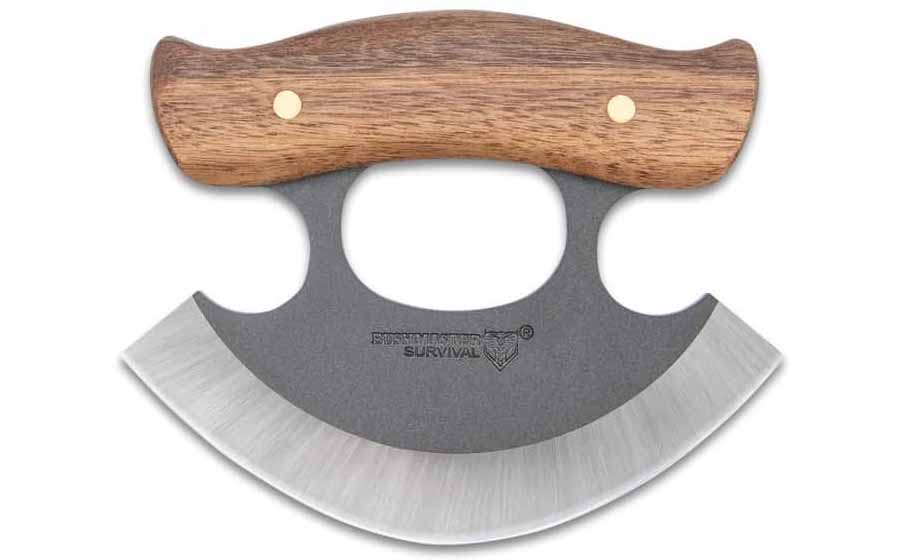
Lastly, we have the Bushmaster Survival Wilderness Ulu, which moves away from the kitchen knife style and more into a true survival or camp knife. It has a very beefy blade made of 1095 high-carbon steel.
If you’re looking to process large game, hack up a rack of ribs, or split some decent-sized logs for the fire, this is the option for you. The hardwood handles are curved to fit most hand sizes, and secured with brass pins.
This Ulu is just under 4.5-inches overall, which makes it a great choice for a variety of camp chores as it’s not too big or too small for most of what you’re likely to have to do out in the woods. At home, it still chops vegetables just as well as any other option we’ve got.
Final Thoughts on the Ulu Knife
The Ulu knife is a great example of traditional wisdom and design that still very much has a place in our modern world. The old saying “If it ain’t broke, don’t fix it” very much applies here, with this knife that is just as at home in our modern world of hustle and bustle as it was in the native communities it originated in thousands of years ago.
Check Out More Buyer’s Guides:
- Best EDC Fixed Blade Knife Options
- Best Bushcraft Knife: When Steel Meets The Woods
- Best Neck Knife: Options To Yoke Up With
- Best Tomahawks: Our Top Hawks For Backwoods To Battlefields
 NEXT STEP: Download Your Free KNIFE GUIDE Issue of BLADE Magazine
NEXT STEP: Download Your Free KNIFE GUIDE Issue of BLADE Magazine
BLADE’s annual Knife Guide Issue features the newest knives and sharpeners, plus knife and axe reviews, knife sheaths, kit knives and a Knife Industry Directory.Get your FREE digital PDF instant download of the annual Knife Guide. No, really! We will email it to you right now when you subscribe to the BLADE email newsletter.







I just read your latest blog post, “BEST ULU KNIFE: BACKGROUND AND BUYER’S GUIDE” and it was truly insightful. I appreciated how you presented the topic with well-researched information. The section about ULU KNIFE was particularly interesting and inspired me to learn more. Your engaging writing style and logical flow made it easy to follow. Thanks for the valuable resources. I’ll keep following your blog! https://www.baramdat.com/blog